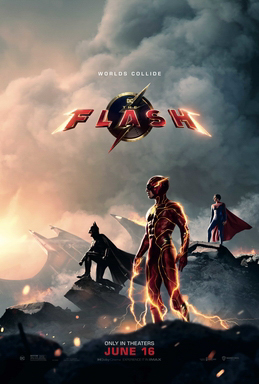REVIEW: ‘The Flash’: Walk, don’t run to the theater
DC tries to do too much in a single movie and creates yet another mess

COURTESY OF WARNER BROS. ENTERTAINMENT
An official poster of “The Flash.”
June 22, 2023
I want to start this review by saying, Michael Keaton’s return as Batman was the best part of “The Flash”; it was really fun to have Danny Elfman’s “Batman” theme peppered throughout the scenes that Keaton starred in. While it is really hard to compare any Batman movie to Christopher Nolan’s iconic “Dark Knight” trilogy, “Batman” (1989), which Keaton starred in, is one of the best Batman movies.
Personally, I saw “The Flash” in IMAX because seeing Michael Keaton say “I’m Batman” on the big screen was a bucket list item of mine.
OK, on to “The Flash.” I had a rough idea of what the plot was going to be inspired by, and that was the “Flashpoint Paradox” story that has been told in multiple iterations across comic books and animated movies.
The rough plotline of the “Flashpoint Paradox” story is — and there will be spoilers for “The Flash” movie here — Barry Allen, also known as the Flash, can run so fast that he can run backward in time.
After he discovers this, he runs back in time to his childhood, when his father was falsely imprisoned for murdering his mother. The Reverse Flash — yes, that is his name — is the one who killed Allen’s mother and wants to make his life miserable for some reason, framing his father for the murder.
Allen runs backward in time and is able to stop Reverse Flash from killing his mother, resulting in his father never being imprisoned. He runs back to the present day to realize everything has changed for the worse and has to make the tough decision to let his mom be killed for the good of the future.
Surprisingly intense for a comic book, right?
There is an animated rendition of this movie, “Justice League: The Flashpoint Paradox,” that is available on streaming services and is honestly way better than this live-action adaptation. I would say that the animated version of the movie is worth a watch, but keep in mind that it is pretty intense for an animated movie.
Back to the new movie, “The Flash” has been mired in controversy due to the leading actor, Ezra Miller, being charged with several crimes, and the movie has had a pretty weak box office reception.
The plot of “The Flash” follows the “Flashpoint Paradox,” omitting the Reverse Flash from the film and toning down the overall intensity factor of the plot from the animated movie.
I was surprised by the main conflict of the plot. When Allen goes forward in time to see how everything turned out after he saved his mom, he pops out of the Speed Force in 2013 to discover that there are no metahumans (Aquaman, Cyborg, etc) so he has to save Superman from a super prison to stop General Zod, which was the plot of the “Man of Steel” movie.
Sitting next to my friend at the showing of the movie, he leaned over to me and said “This feels like a fever dream,” which is the best way that I can think of to describe it.
The movie was not all bad; it was an enjoyable watch for the most part, but it falls into the stereotype of “DC trying to do too much in a single movie and creating a muddled mess.” There were a lot of plot lines, and the end of the movie is a really lame cop-out for an ending.
Director of “Guardians of the Galaxy” movies James Gunn has recently departed Marvel to direct movies at DC, so hopefully, Gunn can right the ship that has been sinking since 2013.
Overall, this movie was entertaining, but I think I would wait for it to come out on a streaming service instead of seeing it in the theater again.








